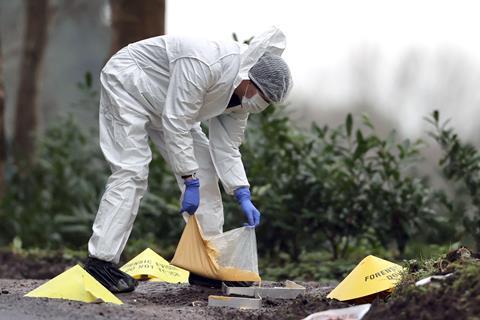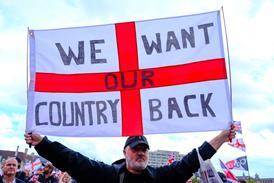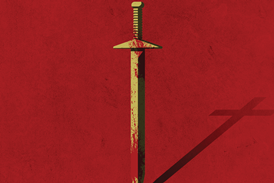Below the surface of normality that has been a product of the Good Friday Agreement, the threat of sectarian violence has never totally gone away. Historian Martyn Whittock unpacks the context that led to Wednesday’s shooting of an off duty police inspector in Omagh

The appalling shooting of Detective Chief Inspector John Caldwell, this past week, is a reminder of the undercurrents of paramilitary violence which exist below the surface of Northern Irish society.
Gunned down after leading a football coaching session for children, the “primary focus” of those tasked with tracking down those responsible, is currently on dissident republicans and the group known as the New IRA.
To many on the British mainland this terrible event, will come as a shock. Surely the Good Friday Agreement put an end to the bloody violence of “the Troubles”?
But to those who live in Northern Ireland, and those following its conflicted politics, the event is less of a surprise. For, below the surface of normality that has been a product of the Good Friday Agreement, the threat (and the reality) of sectarian violence has never totally gone away.
A reminder of troubled times
From the 16th century onwards, British rule in Ireland was frequently only sustainable through coercion and suppression of the Irish population. The majority remained Catholic after the Reformation; and a minority Protestant community was encouraged to settle there (often from Scotland) in order to bolster British rule. Repression of Catholics became hardwired into the system.
From the late 19th century onwards resistance to, or support for, British rule in Ireland increasingly became sectarian. Irish Nationalists (who would increasingly become Republicans) represented Catholics. Unionists (or “Loyalists”) represented Protestants.
The Anglo-Irish Treaty (1921) redrew the map of Ireland so that it was divided between the Irish Free State (the Irish Republic from 1937) and Northern Ireland (which remained part of the UK). Consequently, the Protestant minority in Ireland became the Protestant majority in the newly formed “Northern Ireland.” The Catholic minority in Northern Ireland became a discriminated-against community, who would eventually push back against this status and their community’s poverty in the 1960s.
Most within the Catholic community favoured reunification with the Irish Republic. In contrast, Protestants generally favoured continued membership of the UK.
The inter-communal violence (“the Troubles”), which surged in the 1960s and lasted until the Good Friday Agreement of 1998, saw about 3,600 people killed and over 40,000 wounded. In addition to the British security forces and rival paramilitaries who died, over 1,800 of those killed were unarmed civilians.
Most of these murdered civilians were Catholics. This may come as a surprise to many in mainland Britain because the news there tended to focus more on the carnage as it impacted on the security forces and on Republican atrocities generally. The murder of Catholic civilians by Protestant paramilitaries gained much less news coverage.
The Good Friday Agreement
In 1998 it seemed this violent past was finally ending. The Good Friday Agreement created a new power-sharing government in Northern Ireland (the Northern Irish Assembly and Executive) in which Nationalist/Republican parties (basically Catholics) and Unionist parties (basically Protestants) would cooperate in the government of the province.
In addition, there would be increased cross-border cooperation between the governments of Northern Ireland, the UK, and the Irish Republic. This was made easier by the fact that all were members of the European Union.
What followed was the decommissioning of weapons by the major paramilitary groups on both sides, as something approaching normality developed. However, dissidents on both sides remained unhappy with the new arrangements. Those who gunned down John Caldwell almost certainly came from a dissident Republican group, supporting a united Ireland. But violence continues to simmer below the surface in the Unionist community too.
However, things got much better for most people after the Good Friday Agreement and the cross-border cooperation was easier in an EU context which no longer obsessed about borders. That latter situation was not to last. Enter Brexit.
The impact of Brexit?
In 2016, the majority of people in Northern Ireland voted to remain in the EU and continue a situation in which there was no hard border within Ireland. However, overall the UK voted to leave. This had huge implications for Northern Ireland. On one hand, a new hard border between Northern Ireland and the Irish Republic would break the Good Friday Agreement – and threatens a return to sectarian violence. On the other hand, treating Northern Ireland differently to the rest of the UK antagonises the Unionist community (and Brexiters generally) – and threatens a return to sectarian violence. Attempts to resolve this dilemma, through the so-called “Northern Irish Protocol” continue to cause turbulence on both sides of the Irish Sea.
At present the Protestant DUP party is blocking the functioning of the NI Executive and Assembly because they oppose the Northern Ireland Protocol as a division of the UK. It should be noted that the DUP supported the Brexit decision that led to the situation (resulting in the Protocol) in the first place.
Those who carried out the attack on John Caldwell would probably have done so regardless of the current divisions in NI and the UK over how to resolve the conundrums posed by the result of the Brexit referendum. However, in the fevered atmosphere of Northern Irish politics, Brexit has hardly functioned as a calming influence.
As the 25th anniversary of the Good Friday Agreement approaches, the “Peace Dividend” may no longer be as secure as it once appeared. We live in worrying times.





































No comments yet